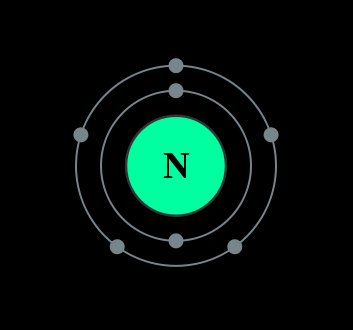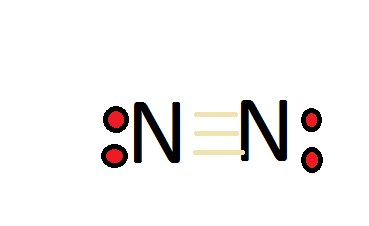What Is the Number of Electrons That an Atom in the Nitrogen Family Usually Gains or Shares
Chemical science of Nitrogen (Z=7)
- Page ID
- 565
Nitrogen is present in almost all proteins and plays important roles in both biochemical applications and industrial applications. Nitrogen forms strong bonds because of its ability to grade a triple bond with its self, and other elements. Thus, there is a lot of free energy in the compounds of nitrogen. Before 100 years ago, niggling was known about nitrogen. Now, nitrogen is commonly used to preserve food, and as a fertilizer.
Introduction
Nitrogen is found to take either 3 or 5 valence electrons and lies at the top of Grouping 15 on the periodic table. It can have either 3 or 5 valence electrons because it tin can bail in the outer 2p and 2s orbitals. Molecular nitrogen (\(N_2\)) is not reactive at standard temperature and pressure and is a colorless and odorless gas.

Nitrogen is a non-metal element that occurs about abundantly in the atmosphere, nitrogen gas (N 2 ) comprises 78.1% of the volume of the Earth'southward air. Information technology just appears in 0.002% of the earth'due south crust by mass. Compounds of nitrogen are found in foods, explosives, poisons, and fertilizers. Nitrogen makes up DNA in the form of nitrogenous bases every bit well as in neurotransmitters. It is i of the largest industrial gases, and is produced commercially as a gas and a liquid.
| Proper noun and Symbol | Nitrogen, N |
| Category | not-metal |
| Atomic Weight | 14.0067 |
| Group | 15 |
| Electron Configuration | 1s2 2s2 2p3 |
| Valence Electrons | 2, v |
| Phase | Gas |
History
Nitrogen, which makes up about 78% of our atmosphere, is a colorless, odorless, tasteless and chemically unreactive gas at room temperature. It is named from the Greek nitron + genes for soda forming. For many years during the 1500'due south and 1600'due south scientists hinted that in that location was another gas in the atmosphere besides carbon dioxide and oxygen. It was non until the 1700'south that scientists could prove there was in fact some other gas that took up mass in the temper of the Earth.
Discovered in 1772 by Daniel Rutherford (and independently past others such as Priestly and Cavendish) who was able to remove oxygen and carbon dioxide from a contained tube full of air. He showed that there was residual gas that did not support combustion like oxygen or carbon dioxide. While his experiment was the one that proved that nitrogen existed, other experiments were also going in London where they called the substance "burnt" or "dephlogisticated air".
Nitrogen is the quaternary most abundant chemical element in humans and information technology is more abundant in the known universe than carbon or silicon. Most commercially produced nitrogen gas is recovered from liquefied air. Of that amount, the bulk is used to manufacture ammonia (\(NH_3\)) via the Haber process. Much is likewise converted to nitric acid (\(HNO_3\)).
Isotopes
Nitrogen has ii naturally occurring isotopes, nitrogen-14 and nitrogen-15, which can be separated with chemical exchanges or thermal diffusion. Nitrogen besides has isotopes with 12, thirteen, 16, 17 masses, but they are radioactive.
- Nitrogen 14 is the nearly abundant form of nitrogen and makes upward more than 99% of all nitrogen found on Earth. It is a stable chemical compound and is non-radioactive. Nitrogen-14 has the most applied uses, and is found in agricultural practices, food preservation, biochemicals, and biomedical inquiry. Nitrogen-fourteen is found in abundance in the atmosphere and among many living organisms. It has 5 valence electrons and is not a proficient electrical conductor.
- Nitrogen-15 is the other stable form of nitrogen. It is often used in medical enquiry and preservation. The chemical element is non-radioactive and therefore can also be sometimes used in agricultural practices. Nitrogen-15 is also used in brain research, specifically nuclear magnetic resonance spectroscopy (NMR), because unlike nitrogen-14 (nuclear spin of 1), it has a nuclear spin of 1/2 which has benefits when it comes to observing MRI enquiry and NMR observations. Lastly, nitrogen-15 can be used as label or in some proteins in biology. Scientists mainly use this compound for research purposes and have not even so seen its full potential for uses in brain inquiry.
Compounds
The ii about common compounds of nitrogen are Potassium Nitrate (KNO3) and Sodium Nitrate (NaNOiii). These 2 compounds are formed by decomposing organic matter that has potassium or sodium present and are often found in fertilizers and byproducts of industrial waste. Nigh nitrogen compounds have a positive Gibbs costless free energy (i.e., reactions are not spontaneous).

The dinitrogen molecule (\(N_2\)) is an "unusually stable" compound, particularly because nitrogen forms a triple bond with itself. This triple bail is difficult hard to pause. For dinitrogen to follow the octet rule, information technology must have a triple bond. Nitrogen has a total of five valence electrons, and so doubling that, we would take a total of ten valence electrons with two nitrogen atoms. The octet requires an cantlet to have viii total electrons in order to have a full valence shell, therefore information technology needs to have a triple bond. The compound is too very inert, since it has a triple bond. Triple bonds are very hard to pause, so they continue their total valence vanquish instead of reacting with other compounds or atoms. Recollect of it this mode, each triple bond is like a condom band, with three prophylactic bands, the nitrogen atoms are very attracted to each other.
Nitrides
Nitrides are compounds of nitrogen with a less electronegative atom; in other words information technology's a compound with atoms that have a less total valence beat. These compounds form with lithium and Group 2 metals. Nitrides commonly has an oxidation state of -3.
\[3Mg + N_2 \rightarrow Mg_3N_2 \label{1}\]
When mixed with water, nitrogen volition class ammonia and, this nitride ion acts every bit a very potent base.
\[N + 3H_2O_{(l)} \rightarrow NH_3 + 3OH^-_{(aq)} \label{two}\]
When nitrogen forms with other compounds information technology primarily forms covalent bonds. These are normally done with other metals and look like: MN, One thousand3Northward, and M4N. These compounds are typically hard, inert, and have high melting points because nitrogen's ability to course triple covalent bonds.
Ammonium Ions
Nitrogen goes through fixation past reaction with hydrogen gas over a goad. This process is used to produce ammonia. Equally mentioned earlier, this process allows us to use nitrogen equally a fertilizer considering it breaks down the strong triple bond held by N2 . The famous Haber-Bosch process for synthesis of ammonia looks like this:
\[N_2 + 3H_2 \rightarrow 2NH_3 \label{3}\]
Ammonia is a base and is too used in typical acid-base reactions.
\[2NH_{3(aq)} + H_2SO_4 \rightarrow (NH_4)_2SO_{iv(aq)} \label{4}\]
Nitride ions are very strong bases, especially in aqueous solutions.
Oxides of Nitrogen
Nitrides utilise a diverseness of different oxidation numbers from +1 to +5 to for oxide compounds. Nigh all the oxides that form are gasses, and exist at 25 degrees Celsius. Oxides of nitrogen are acidic and easily attach protons.
\[N_2O_5 + H_2O \rightarrow 2HNO_{three (aq)} \label{5}\]
The oxides play a large role in living organisms. They tin can exist useful, nevertheless dangerous.
- Dinitrogen monoxide (NorthtwoO) is a anesthetic used at the dentist every bit a laughing gas.
- Nitrogen dioxide (NO2) is harmful. Information technology binds to hemoglobin molecules not allowing the molecule to release oxygen throughout the body. It is released from cars and is very harmful.
- Nitrate (NOiii -) is a polyatomic ion.
- The more unstable nitrogen oxides let for space travel.
Hydrides
Hydrides of nitrogen include ammonia (NHiii) and hyrdrazine (N2Hiv).
- In aqueous solution, ammonia forms the ammonium ion which we described above and information technology has special amphiprotic backdrop.
- Hyrdrazine is normally used equally rocket fuel
Applications of Nitrogen
- Nitrogen provides a blanketing for our atmosphere for the production of chemicals and electronic compartments.
- Nitrogen is used as fertilizer in agriculture to promote growth.
- Pressurized gas for oil.
- Refrigerant (such as freezing nutrient fast)
- Explosives.
- Metals treatment/protectant via exposure to nitrogen instead of oxygen
References
- Petrucci, Ralph H, William Harwood, and F. Herring. Full general Chemistry: Principles and Modernistic Applications. 8thursday Ed. New Bailiwick of jersey: Pearson Education Inc, 2001.
- Sadava, David et al. LIFE: The Science of Biology. Eighth Edition. Sinauer Associate.
- Thomas, Jacob. Nitrogen and its Applications to Modern Future. San Diego Land Academy Press: 2007.
Problems
- Complete and residual the following equations
N2 + ___Hii→ ___NH_
H2Due north2O2 → ?
2NH3 + CO2 → ?
__Mg + Due north2 → Mg_N_
NiiHfive + H2O → ?
- What are the different isotopes of Nitrogen?
- Listing the oxiadation states of diverse nitrogen oxides: NorthtwoO, NO, N2Othree , NtwoOiv , NorthwardtwoOv
- List the dissimilar elements that Nitrogen will react with to make it basic or acidic....
- Uses of nitrogen
Answers
- Complete and balance the following equations
North2 + 3H2→ 2NH3(Haber process)
H2North2Oii → HNO
2NH3 + COii → (NHii)2CO + HiiO
2Mg + 3Nii → MgthreeNorthward2
NiiH5 + H2O → Due north2+ H+ + HtwoO
- What are the dissimilar isotopes of Nitrogen?
Stable forms include nitrogen-14 and nitrogen-15
- Listing the oxidation states of various nitrogen oxides: +1, +2, +3, +4, +5 respectively
- List the different elements that Nitrogen will react with to go far basic or acidic :Nitride ion is a strong base when reacted with water, Ammonia is generally a weak acid
- Uses of nitrogen include anesthetic, Refrigerant, metal protector
Contributors
- Adam Wandell (UC Davis)
Source: https://chem.libretexts.org/Bookshelves/Inorganic_Chemistry/Supplemental_Modules_and_Websites_%28Inorganic_Chemistry%29/Descriptive_Chemistry/Elements_Organized_by_Block/2_p-Block_Elements/Group_15:_The_Nitrogen_Family/Z007_Chemistry_of_Nitrogen_%28Z7%29
0 Response to "What Is the Number of Electrons That an Atom in the Nitrogen Family Usually Gains or Shares"
إرسال تعليق